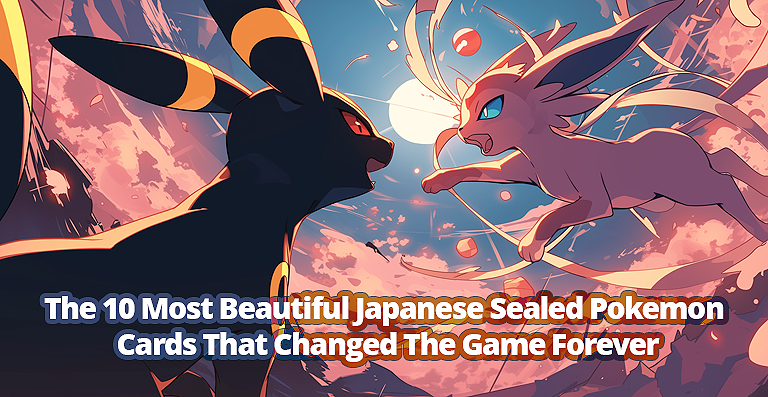The Ultimate Guide to Collecting Sealed Japanese Pokemon Cards

The Ultimate Guide to Collecting Sealed Japanese Pokemon Cards
For Pokemon card collectors and enthusiasts, sealed Japanese Pokemon cards hold a special allure. Known for their rarity, unique artwork, and superior quality, these coveted cards have captured the hearts of collectors worldwide.
In this comprehensive guide, we'll explore the fascinating world of sealed Japanese Pokemon cards, delving into their history, notable sets, and the factors that make them highly sought-after by collectors.
The Origins of Japanese Pokemon Cards
The Pokemon Trading Card Game (TCG) first emerged in Japan in October 1996, with the release of the Base Set by Media Factory. This inaugural set, featuring 102 cards, laid the foundation for the game's subsequent success and global expansion.
As the popularity of Pokemon soared, additional Japanese expansion sets, such as Jungle and Fossil, were released, introducing new Pokemon and gameplay mechanics.
Exclusive Japanese Pokemon Card Sets:One of the most appealing aspects of collecting sealed Japanese Pokemon cards is the existence of exclusive sets and promotional releases not available in other regions.
These limited-edition sets often feature unique artwork, holographic patterns, and rare cards that are highly coveted by collectors.
Some notable examples include:
- Vending Series Sets (1997-2000)
- Tropical Mega Battle Cards (1999)
- Pokemon Web Sets (1999-2001)
- Pokemon VS Series (2001-2004)
- Battle Road Participation Cards (2002-2005)

The Allure of Sealed Japanese Pokemon Cards
Sealed Japanese Pokemon cards hold a special appeal for collectors due to several key factors:
- Rarity: Many Japanese sets were produced in limited quantities, making them scarce and highly sought-after.
- Unique Artwork: Japanese cards often feature exclusive illustrations and designs not found in their English counterparts.
- Superior Quality: Japanese cards are known for their exceptional print quality, vibrant colors, and sturdy card stock.
- Cultural Significance: Owning Japanese Pokemon cards allows collectors to possess a piece of the franchise's origins and cultural heritage.
Factors Affecting the Value of Sealed Japanese Pokemon Cards
Several factors contribute to the value and collectibility of sealed Japanese Pokemon cards:
- Rarity: Scarce promotional cards, limited edition sets, and old vintage packs command higher prices.
- Condition: Sealed products in pristine condition, without any tears, dents, or signs of wear, are most desirable.
- Popularity: Sets featuring iconic Pokemon or notable artwork tend to be more valuable.
- Age: Older sets from the early years of the Pokemon TCG often hold significant value due to their historical significance and scarcity.

How to Collect Sealed Japanese Pokemon Cards
For those interested in starting or expanding a collection of sealed Japanese Pokemon cards, consider the following tips:
- Research: Familiarize yourself with the various Japanese sets, their release dates, and notable cards.
- Authenticity: Ensure you are purchasing genuine sealed products from reputable sources to avoid counterfeits.
- Condition: Prioritize sealed products in excellent condition to maximize their value and collectibility.
- Storage: Properly store your sealed Japanese Pokemon cards in a cool, dry place to preserve their condition.
- Budget: Set a budget and prioritize acquisitions based on your collecting goals and preferences.
Conclusion
Collecting sealed Japanese Pokemon cards is a rewarding and exciting endeavor for Pokemon enthusiasts and collectors alike. With their rich history, exclusive artwork, superior quality, and
cultural significance, these cards offer a unique opportunity to own a piece of Pokemon's legacy.
By understanding the factors that influence value, staying informed about notable sets, and following best practices for acquisition and storage, collectors can curate an impressive collection of sealed Japanese Pokemon cards that will be treasured for years to come.
FAQs:
1. What is the rarest sealed Japanese Pokemon card?
Some of the rarest sealed Japanese Pokemon cards include:
- Pikachu Illustrator Card (1998): Given as a prize for a drawing contest, only 39 copies are known to exist.
- Tamamushi University Magikarp Card (1998): A promotional card distributed at a Japanese university event.
- Tropical Mega Battle Cards (1999): Exclusive cards awarded to participants of a tournament in Hawaii.
- Pokemon Web Set (1999): A limited-edition set available only through the Pokemon Web online service.
To ensure the authenticity of a sealed Japanese Pokemon card, consider the following:
- Verify the seller's reputation and read reviews from previous buyers.
- Check for official logos, trademarks, and copyright information on the packaging.
- Compare the product's appearance with images of authentic sealed cards from reliable sources.
- Be cautious of deals that seem too good to be true, as they may indicate counterfeits.
- In case of doubt, consult experts or reputable authentication services.
Sealed Japanese Pokemon cards can be purchased from various sources, including:
- Online marketplaces like eBay and Amazon, ensuring to buy from reputable sellers with positive reviews.
- Specialized trading card websites and online card shops that deal in Japanese Pokemon products.
- Local hobby stores or collectible shops that import Japanese trading cards.
- Japanese auction sites and proxy services, which may offer a wider selection but require additional shipping arrangements.
We have a wide range of Japanese sealed product available in our store, which you can find here:
https://deckoutgaming.ca/collections/pokemon-japanese-sealed-product
4. How should I store my sealed Japanese Pokemon cards to maintain their condition?
To preserve the condition of your sealed Japanese Pokemon cards, follow these storage tips:
- Keep the cards in a cool, dry place away from direct sunlight, heat, and humidity.
- Store the sealed products in acid-free protective sleeves or cases designed for trading cards.
- Consider using rigid toploaders or cardboard backers for added protection during storage or transportation.
- Avoid handling the sealed products excessively to minimize wear and tear.
- If displaying the cards, use UV-protective frames or display cases to prevent fading and damage.
The value of sealed Japanese Pokemon cards can vary considerably compared to their English counterparts due to several factors:
- Rarity: Japanese exclusive sets and promotional releases are often more limited in quantity, increasing their value.
- Artwork: Unique Japanese illustrations and designs can command higher prices among collectors.
- Quality: The superior print quality and card stock of Japanese cards can contribute to their increased value.
- Demand: The global collectible market and the preferences of international collectors influence the value of Japanese cards.
In general, rare and exclusive sealed Japanese Pokemon cards can be significantly more valuable than their English equivalents, especially for vintage sets and promotional releases.
However, the value ultimately depends on factors such as rarity, condition, and market demand.




